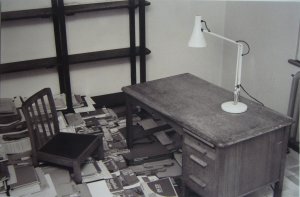b1962
< BACK
Mathew Gibson was born in London in 1962. He studied at Norwich School of Art (BA Hons Fine Art, 1987-90) and at Kent Institute of Art & Design (MA Art & Architecture, 1990-91). He has been a lecturer at various art schools and colleges in Britain, and from 2006-07 he was Professor of Foundation studies at SCAD, Savannah, USA. He currently lives and works in London.
Gibson's early installations were temporary in nature, and influenced by the work of Jannis Kounellis and Illya Kabakov. However, since he began to make paintings after 2000, Gibson has sought to work in a more personal and intimate way. The process of egg tempera painting aligns itself strongly with his concerns. The planning and preparation of tempera paintings leave no room for painterly gesture or spontaneity. The process lends itself to the development of an imaginary three dimensional architectural space. Complete drawings, usually in two- or three-point perspective like an architect's mock-ups, are transferred onto gesso panels. Multiple layers of thin paint are then methodically applied until the characteristic matt sheen of tempera paintings is achieved.
Mathew Gibson uses 'the idea of architecture as a psychological space': he paints small-scale, intensely worked tempera pictures of mysteriously disquieting interiors. For a decade through the 1990s, Gibson made objects and installations using everyday materials and items as a way of engaging with architectural spaces, but since 2000, he has focused on painting miniature worlds or 'theatres of memory', as an extension of his fascination with architectural spaces at night.
The spaces he depicts appear to be functional and often evoke human presence through the very absence of inhabitants. The viewpoint is detached and set high, suggesting surveillance cameras or non-human observation. Questions about what the spaces are for and who uses them are left for the viewer to complete. In many of his most recent works, the spaces he depicts are often populated and their function is less specific. Another recent series of small works concentrates on figures lying down - sleeping, smoking or reading - lost in their own private reveries.
Although Gibson uses familiar forms and images, his paintings have an almost haunted quality of otherworldliness. They have an affinity with the work of the American James Casabere: both artists create fictional worlds and miniature uninhabited spaces that evoke a sense of 'alienated intimacy'. Gibson cites artists such as the 18th-century printmaker Giovanni Battista Piranesi and the 15th-century Siennese painter Sassetta as specific influences on his paintings, and Piranesi's series of etchings, the Carceri d'invenzione (imaginary prisons) with their subterranean vaults and stairs, although more gothic in conception, portray equally fictional spaces.
Gibson's early installations were temporary in nature, and influenced by the work of Jannis Kounellis and Illya Kabakov. However, since he began to make paintings after 2000, Gibson has sought to work in a more personal and intimate way. The process of egg tempera painting aligns itself strongly with his concerns. The planning and preparation of tempera paintings leave no room for painterly gesture or spontaneity. The process lends itself to the development of an imaginary three dimensional architectural space. Complete drawings, usually in two- or three-point perspective like an architect's mock-ups, are transferred onto gesso panels. Multiple layers of thin paint are then methodically applied until the characteristic matt sheen of tempera paintings is achieved.
The low-lit spaces occupy a netherworld of the imagination; the paintings make concrete the fears and re-alignments of dreamlike states of mind. When the critic Frank Whitford described Gibson's painting Library with Desks, he noted that 'there is something unnerving about this accomplished painting. Probably it is the high viewpoint, the impractical height of the bookcases and the total lack of books. The single pool of light on the desk emphasises the emptiness of the place.'

Mathew Gibson 'Paperwork' 1999 Installation
